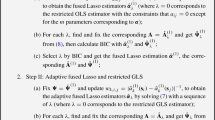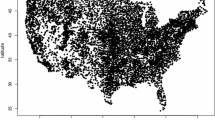Abstract
In this chapter, we introduce the concept of fractional integration for spatial autoregressive models. We show that the range of the dependence can be spatially extended or diminished by introducing a further fractional integration parameter to spatial autoregressive moving average models (SARMA). This new model is called spatial autoregressive fractionally integrated moving average model, briefly spARFIMA. We show the relation to time-series ARFIMA models and also to (higher-order) spatial autoregressive models. Moreover, an estimation procedure based on the maximum-likelihood principle is introduced and analysed in a series of simulation studies. Eventually, the use of the model is illustrated by an empirical example of atmospheric fine particles, so-called aerosol optical thickness, which is important in weather, climate, and environmental science.
Access this chapter
Tax calculation will be finalised at checkout
Purchases are for personal use only
Similar content being viewed by others
References
Basak, G. K., Bhattacharjee, A., & Das, S. (2018). Causal ordering and inference on acyclic networks. Empirical Economics, 55(1), 213–232.
Beran, J. (2017). Statistics for long-memory processes. Routledge.
Beran, J., Ghosh, S., & Schell, D. (2009). On least squares estimation for long-memory lattice processes. Journal of Multivariate Analysis, 100(10), 2178–2194.
Boissy, Y., Bhattacharyya, B., Li, X., Richardson, G., et al. (2005). Parameter estimates for fractional autoregressive spatial processes. The Annals of Statistics, 33(6), 2553–2567.
Doğan, O., & Taşpınar, S. (2013). GMM estimation of spatial autoregressive models with moving average disturbances. Regional Science and Urban Economics, 43(6), 903–926.
Elhorst, J. P., Lacombe, D. J., & Piras, G. (2012). On model specification and parameter space definitions in higher order spatial econometric models. Regional Science and Urban Economics, 42(1–2), 211–220.
Ghalanos, A., & Theussl, S. (2012). Rsolnp: General Non-linear Optimization Using Augmented Lagrange Multiplier Method. R package version 1.14.
Ghodsi, A., & Shitan, M. (2009). Estimation of the memory parameters of the fractionally integrated separable spatial autoregressive (FISSAR (1, 1)) model: A simulation study. Communications in Statistics-Simulation and Computation, 38(6), 1256–1268.
Gibbons, S., & Overman, H. G. (2012). Mostly pointless spatial econometrics? Journal of Regional Science, 52(2), 172–191.
Gupta, P., Khan, M. N., da Silva, A., & Patadia, F. (2013). Modis aerosol optical depth observations over urban areas in Pakistan: quantity and quality of the data for air quality monitoring. Atmospheric pollution research, 4(1), 43–52.
Kumar, N., Chu, A., & Foster, A. (2007). An empirical relationship between PM2. 5 and aerosol optical depth in Delhi metropolitan. Atmospheric Environment, 41(21), 4492–4503.
Lahiri, S., Robinson, P. M., et al. (2016). Central limit theorems for long range dependent spatial linear processes. Bernoulli, 22(1), 345–375.
Lam, C., & Souza, P. C. (2016). Detection and estimation of block structure in spatial weight matrix. Econometric Reviews, 35(8–10), 1347–1376.
Leonenko, N., & Taufer, E. (2013). Disaggregation of spatial autoregressive processes. Spatial Statistics, 3, 1–20.
Manski, C. F. (1993). Identification of endogenous social effects: The reflection problem. The Review of Economic Studies, 60(3), 531–542.
Martin, R. (1979). A subclass of lattice processes applied to a problem in planar sampling. Biometrika, 66(2), 209–217.
Merk, M. S., & Otto, P. (2021). Directional spatial autoregressive dependence in the conditional first-and second-order moments. Spatial Statistics, 41, 100490.
Ord, K. (1975). Estimation methods for models of spatial interaction. Journal of the American Statistical Association, 70(349), 120–126.
Otto, P., & Steinert, R. (2022). Estimation of the spatial weighting matrix for spatiotemporal data under the presence of structural breaks. Journal of Computational and Graphical Statistics, 32(2), 696–711. https://doi.org/10.1080/10618600.2022.2107530.
Robinson, P. M. (2020). Spatial long memory. Japanese Journal of Statistics and Data Science, 3(1), 243–256.
Robinson, P. M., & Sanz, J. V. (2006). Modified whittle estimation of multilateral models on a lattice. Journal of Multivariate Analysis, 97(5), 1090–1120.
Shitan, M. (2008). Fractionally integrated separable spatial autoregressive (FISSAR) model and some of its properties. Communications in Statistics—Theory and Methods, 37(8), 1266–1273.
Van Donkelaar, A., Martin, R. V., Brauer, M., Kahn, R., Levy, R., Verduzco, C., & Villeneuve, P. J. (2010). Global estimates of ambient fine particulate matter concentrations from satellite-based aerosol optical depth: development and application. Environmental health perspectives, 118(6), 847–855.
Wang, J., & Christopher, S. A. (2003). Intercomparison between satellite-derived aerosol optical thickness and PM2. 5 mass: Implications for air quality studies. Geophysical Research Letters, 30(21), 2095. https://doi.org/10.1029/2003GL018174.
Author information
Authors and Affiliations
Corresponding author
Editor information
Editors and Affiliations
Rights and permissions
Copyright information
© 2024 The Author(s), under exclusive license to Springer Nature Switzerland AG
About this chapter
Cite this chapter
Otto, P., Sibbertsen, P. (2024). Spatial Autoregressive Fractionally Integrated Moving Average Model. In: Knoth, S., Okhrin, Y., Otto, P. (eds) Advanced Statistical Methods in Process Monitoring, Finance, and Environmental Science. Springer, Cham. https://doi.org/10.1007/978-3-031-69111-9_22
Download citation
DOI: https://doi.org/10.1007/978-3-031-69111-9_22
Published:
Publisher Name: Springer, Cham
Print ISBN: 978-3-031-69110-2
Online ISBN: 978-3-031-69111-9
eBook Packages: Mathematics and StatisticsMathematics and Statistics (R0)




